My notes from the 'user generated content' parallel track on first day of the Open Culture 2010 conference. The session started with brief presentations by panellists, then group discussions at various tables on questions suggested by the organisers. These notes are quite rough, and of course any mistakes are mine. I haven't had a chance to look for the speakers' slides yet so inevitably some bits are missing, and I can only report the discussion at the table I was at in the break-out session. I've also blogged my notes from the plenary session of the Open Culture 2010 conference.
User-generated content session, Open Culture, Europeana – the benefits and challenges of UGC.
Kevin Sumption, User-generated content, a MUST DO for cultural institutions
His background – originally a curator of computer sciences. One of first projects he worked on at Powerhouse was D*Hub which presented design collections from V&A, Brooklyn Museum and Powerhouse Museum – it was for curators but also for general public with an interest in design. Been the source of innovation. Editorial crowd-sourcing approach and social tagging, about 8 years ago.
Two years ago he moved to National Maritime Museum, Royal Observatory, Greenwich. One of the first things they did was get involved with Flickr Commons – get historic photographs into public domain, get people involved in tagging. c1000 records in there. General public have been able to identify some images as Adam Villiers images – specialists help provide attribution for the photographer. Only for tens of records of the 000s but was a good introduction to power of UGC.
Building hybrid exhibition experiences – astronomy photographer of the year – competition on Flickr with real world exhibition for the winners of the competition. 'Blog' with 2000 amateur astronomers, 50 posts a day. Through power of Flickr has become a significant competition and brand in two years.
Joined citizen science consortia. Galaxy Zoo. Brainchild of Oxford – getting public engaged with real science online. Solar Stormwatch c 3000 people analysing and using the data. Many people who get involved gave up science in high school… but people are getting re-engaged with science *and* making meaningful contributions.
Old Weather – helping solve real-world problems with crowdsourcing. Launched two months ago.
Passion for UGC is based around where projects can join very carefully considered consortia, bringing historical datasets with real scientific problems. Can bring large interested public to the project. Many of the public are reconnecting with historical subject matter or sciences.
Judith Bensa-Moortgat, Nationaal Archief, Netherlands, Images for the Future project
Photo collection of more than 1 million photos. Images for the future project aims to save audio-visual heritage through digitisation and conservation of 1.2 million photos.
Once digitised, they optimise by adding metadata and context. Have own documentalists who can add metadata, but it would take years to go through it all. So decided to try using online community to help enrich photo collections. Using existing platforms like Wikipedia, Flickr, Open Street map, they aim to retrieve contextual info generated by the communities. They donated political portraits to Wikimedia Commons and within three weeks more than half had been linked to relevant articles.
Their experiences with Flickr Commons – they joined in 2008. Main goal was to see if community would enrich their photos with comments and tags. In two weeks, they had 400,000 page views for 400 photos, including peaks when on Dutch TV news. In six months, they had 800 photos with over 1 million views. In Oct 2010, they are averaging 100,000 page views a month; 3 million overall.
But what about comments etc? Divided them into categories of comments [with percentage of overall contributions]:
- factual info about location, period, people 5%;
- link to other sources eg Wikipedia 5%;
- personal stories/memories (e.g. someone in image was recognised);
- moral discussions;
- aesthetical discussions;
- translations.
The first two are most important for them.
13,000 tags in many languages (unique tags or total?).
10% of the contributed UGC was useful for contextualisation; tags ensure accessibility [discoverability?] on the web; increased (international) visibility. [Obviously the figures will vary for different projects, depending on what the original intent of the project was]
The issues she'd like to discuss are – copyright, moderation, platforms, community.
Mette Bom, 1001 Stories about Denmark
Story of the day is one of the 1001 stories. It's a website about the history and culture of Denmark. The stories have themes, are connected to a timeline. Started with 50 themes, 180 expert writers writing the 1001 stories, now it's up to the public to comment and write their own stories. Broad definition of what heritage is – from oldest settlement to the 'porn street' – they wanted to expand the definition of heritage.
Target audiences – tourists going to those places; local dedicated experts who have knowledge to contribute. Wanted to take Danish heritage out of museums.
They've created the main website, mobile apps, widget for other sites, web service. Launched in May 2010. 20,000 monthly users. 147 new places added, 1500 pictures added.
Main challenges – how to keep users coming back? 85% new, 15% repeat visitors (ok as aimed at tourists but would like more comments). How to keep press interested and get media coverage? Had a good buzz at the start cos of the celebrities. How to define participation? Is it enough to just be a visitor?
Johan Oomen, Netherlands Institute for Sound and Vision, Vrij Uni Amsterdam. Participatory Heritage: the case of the Waisda? video labelling game.
They're using game mechanisms to get people to help them catalogue content. [sounds familiar!]
'In the end, the crowd still rules'.
. Tagging is a good way to facilitate time-based annotation [i.e. tag what's on the screen at different times]
Goal of game is consensus between players. Best example in heritage is steve.museum; much of the thinking about using tagging as a game came from Games with a Purpose (gwap.com). Basic rule – players score points when their tag exactly matches the tag entered by another within 10 seconds. Other scoring mechanisms. Lots of channels with images continuously playing.
Linking it to twitter – shout out to friends to come join them playing. Generating traffic – one of the main challenges. Altruistic message 'help the archive' 'improve access to collections' came out of research with users on messages that worked. Worked with existing communities.
Results, first six months – 44,362 pageviews. 340,000 tags to 604 items, 42,068 unique tags.
Matches – 42% of tags entered more than 2 times. Also looked at vocab (GTAA, Cornetto), 1/3 words were valid Dutch words, but only a few part of thesauruses. Tags evaluated by documentalists. Documentary film 85% – tags were useful; for reality series (with less semantic density) tags less useful.
Now looking at how to present tags on the catalogue Powerhouse Museum style. Experimenting with visualising terms, tag clouds when terms represented, also makes it easy to navigate within the video – would have been difficult to do with professional metadata. Looking at 'tag gardening' – invite people to go back to their tags and click to confirm – e.g. show images with particular tags, get more points for doing it.
Future work – tag matching – synonyms and more specific terms – will get more points for more specific terms.
Panel overview by Costis Dallas, research fellow at Athena, assistant professor at Panteion University, Athens.
He wants to add a different dimension – user-generated content as it becomes an object for memory organisations. New body of resources emerging through these communication practices.
Also, we don't have a historiography anymore; memory resides in personal information devices. Mashups, changes in information forms, complex composed information on social networks – these raise new problems for collecting – structural, legal, preservation in context, layered composition. What do we need to do now in order to be able to make use of digital technologies in appropriate, meaningful ways in the future? New kinds of content, participatory curation are challenges for preservation.
Group discussion (breakout tables)
Discussion about how to attract users. [It wasn't defined whether it was how to attract specifically users who'll contribute content or just generally grow the audience and therefore grow the number of content creators within the usual proportions of levels of participation e.g. Nielsen, Forrester; I would also have liked to discussed how to encourage particular kinds of contributions, or to build architectures of participation that provided positive feedback to encourage deeper levels of participation.]
Discussion and conclusions included – go with the strengths of your collections e.g. if one particular audience or content-attracting theme emerges, go with it. Norway has a national portal where people can add content. They held lots of workshops for possible content creators; made contact with specialist organisations [from which you can take the lesson that UGC doesn't happen in a vacuum, and that it helps to invest time and resources into enabling participants and soliciting content]. Recording living history. Physical presence in gallery, at events, is important. Go where audiences already are; use existing platforms.
Discussion about moderation included – once you have comments, how are they integrated back into collections and digital asset management systems? What do you do about incorrect UGC displayed on a page? Not an issue if you separate UGC from museum/authoritative content in the interface design. In the discussion it turned out that Europeana doesn't have a definition of 'moderation'. IMO, it should include community management, including acknowledging and thanking people for contributions (or rather, moderation is a subset of community management). It also includes approving or reviewing and publishing content, dealing with corrections suggested by contributors, dealing with incorrect or offensive UGC, adding improved metadata back to collections repositories.
User-generated content and trust – British Library apparently has 'trusted communities' on their audio content – academic communities (by domain name?) and 'everyone else'. Let other people report content to help weed out bad content.
Then we got onto a really interesting discussion of which country or culture's version of 'offensive' would be used in moderating content. Having worked in the UK and the Netherlands, I know that what's considered a really rude swear word and what's common vocabulary is quite different in each country… but would there be any content left if you considered the lowest common standards for each country? [Though thinking about it later, people manage to watch films and TV and popular music from other countries so I guess they can deal with different standards when it's in context.] To take an extreme content example, a Nazi uniform as memorabilia is illegal in Germany (IIRC) but in the UK it's a fancy dress outfit for a member of the royal family.
Panel reporting back from various table discussions
Kevin's report – discussion varied but similar themes across the two tables. One – focus on the call to action, why should people participate, what's the motivation? How to encourage people to participate? Competitions suggested as one solution, media interest (especially sustained). Notion of core group who'll energise others. Small groups of highly motivated individuals and groups who can act as catalysts [how to recruit, reward, retain]. Use social media to help launch project.
1001 Danish Stories promotional video effectively showed how easy the process of contributing content was, and that it doesn't have to to be perfect (the video includes celebrities working the camera [and also being a bit daggy, which I later realised was quite powerful – they weren't cool and aloof]).
Giving users something back – it's not a one-way process. Recognition is important. Immediacy too – if participating in a project, people want to see their contributions acknowledged quickly. Long approval processes lose people.
Removal of content – when different social, political backgrounds with different notions of censorship.
Mette's report – how to get users to contribute – answers mostly to take away the boundaries, give the users more credit than we otherwise tend to. We always think users will mess things up and experts will be embarrassed by user content but not the case. In 1001 they had experts correcting other experts. Trust users more, involve experts, ask users what they want. Show you appreciate users, have a dialouge, create community. Make it a part of life and environment of users. Find out who your users are.
Second group – how Europeana can use the content provided in all its forms. Could build web services to present content from different places, linking between different applications.
How to set up goals for user activity – didn't get a lot of answers but one possibility is to start and see how users contribute as you go along. [I also think you shouldn't be experimenting with UGC without some goal in mind – how else will you know if your experiment succeeded? It also focusses your interaction and interface design and gives the user some parameters (much more useful than an intimidating blank page)].
Judith's report (including our table) – motivation and moderation in relation to Europeana – challenging as Europeana are not the owners of the material; also dealing with multilingual collections. Culturally-specific offensive comments. Definition and expectations of Europeana moderation. Resources need if Europeana does the moderation.
Incentives for moderation – improving data, idealism, helping with translations – people like to help translate.
Johan's report – rewards are important – place users in social charts or give them a feeling of contributing to larger thing; tap into existing community; translate physical world into digital analogue.
Institutional policy – need a clear strategy for e.g. how to integrate the knowledge into the catalogue. Provide training for staff on working with users and online tools. There's value in employing community managers to give people feedback when they leave content.
Using Amazon's Mechanical Turk for annotations…
Doing the projects isn't only of benefit in enriching metadata but also for giving insight into users – discover audiences with particular interests.
Costis commenting – if Europeana only has thumbnails and metadata, is it a missed opportunity to get UGC on more detailed content?
Is Europeana highbrow compared to other platforms like Flickr, FB, so would people be afraid to contribute? [probably – there must be design patterns for encouraging participation from audiences on museum sites, but we're still figuring out what they are]
Business model for crowdsourcing – producing multilingual resources is perfect case for Europeana.
Open to the floor for questions… Importance of local communities, getting out there, using libraries to train people. Local newspapers, connecting to existing communities.





